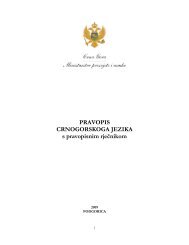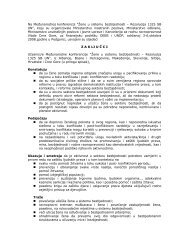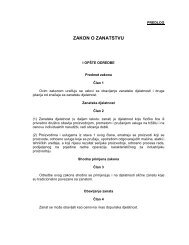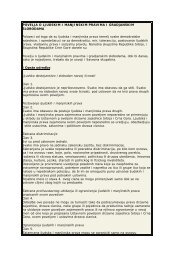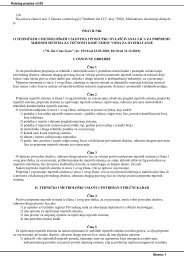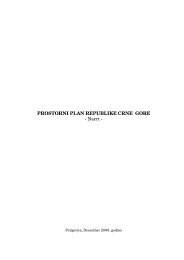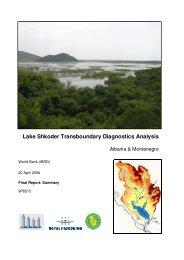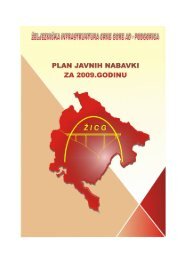arhitektonski atlas crne gore architectural atlas of ... - Vlada Crne Gore
arhitektonski atlas crne gore architectural atlas of ... - Vlada Crne Gore
arhitektonski atlas crne gore architectural atlas of ... - Vlada Crne Gore
You also want an ePaper? Increase the reach of your titles
YUMPU automatically turns print PDFs into web optimized ePapers that Google loves.
commissioned by:Republika Crna GoraMinistarstvo za ekonomski razvojNjemač ka tehnič ka saradnja | German Technical Cooperationpreporuke za građenjerecommendations for construction<strong>arhitektonski</strong> <strong>atlas</strong> <strong>crne</strong> <strong>gore</strong><strong>architectural</strong> <strong>atlas</strong> <strong>of</strong> montenegroOktobar | 2006 | October
SADRŽAJuvod1. Regionalizacija teritorije <strong>Crne</strong> <strong>Gore</strong> u kontekstu teme publikacije2. Tipologija tradicionalnih naselja2.1. Tipologija tradicionalnih naselja po regijama2.2. Tipologija tradicionalnih ruralnih naselja po regijama2.2.1. Ruralna naselja u primorju i karstnoj oblasti2.2.2. Ruralna naselja u oblasti visokih planina3. Tipologija tradicionalne varoške i seoske kuće i elementiarhitekture3.1. Tipologija i elementi arhitekture u okviru južne regije3.1.1. Tipologija varoške kuće3.1.2. Elementi varoške arhitekture u primorju3.1.3. Tipologija seoske kuće u primorju3.2. Tipologija i elementi arhitekture u okviru središnje regije3.2.1. Tipologija varoške kuće u karstnoj oblasti3.2.2. Elementi varoške arhitekture3.2.3. Tipologija seoske kuće u karstnoj oblasti i priobalju Skadarskogjezera3.3. Tipologija i elementi arhitekture u okviru sjeverne regije3.3.1. Tipologija varoške kuće u oblasti visokih planina3.3.2. Elementi varoške arhitekture3.3.3. Tipologija seoske kuće u oblasti visokih planina4. Savremene realizacije i preporuke za građenje na nivou regija4.1. Karakteristike savremene prakse i potencijali studije4.2. Pristupi u savremenoj interpretaciji tradicionalne arhitekture4.3. Pozitivni primjeri odnosa prema kontekstu kao preporuke za građenjena nivou regija4.4. Preporuke za građenje - elementi za urbanističko-tehničke usloveCONTENTSintroduction1. Regionalization <strong>of</strong> the territory <strong>of</strong> Montenegro within the context<strong>of</strong> the topic <strong>of</strong> publication2. Typology <strong>of</strong> the traditional settlements2.1. Typology <strong>of</strong> the traditional settlements by regions2.2. Typology <strong>of</strong> the traditional rural settlements by regions2.2.1. Rural settlements at the Coast and Karst areas2.2.2. Rural settlements in the area <strong>of</strong> high mountains3. Typology <strong>of</strong> the traditional houses in urban settlements and invillages and elements <strong>of</strong> architecture3.1. Typology and elements <strong>of</strong> architecture in the frame <strong>of</strong> Southern region3.1.1. Typology <strong>of</strong> the house in urban settlements3.1.2. Elements <strong>of</strong> urban settlements architecture at the Coast3.1.3. Typology <strong>of</strong> the rural house at the Coast3.2. Typology and elements <strong>of</strong> architecture in the frame <strong>of</strong> Central region3.2.1. Typology <strong>of</strong> the urban settlements house in Karst area3.2.2. Elements <strong>of</strong> the urban settlements architecture3.2.3. Typology <strong>of</strong> the rural house in Karst area and Skadar Lake coast3.3. Typology and elements <strong>of</strong> architecture in the frame <strong>of</strong> Northern region3.3.1. Typology <strong>of</strong> the urban settlements house in the area <strong>of</strong> high mountains3.3.2. Elements <strong>of</strong> urban settlements architecture3.3.3. Typology <strong>of</strong> the rural house in the area <strong>of</strong> high mountains3.3.4. Elements <strong>of</strong> rural architecture4. Contemporary realizations and recommendations for constructionat the level <strong>of</strong> regions4.1. Characteristics <strong>of</strong> contemporary practice and potentials <strong>of</strong> the study4.2. Approaches in contemporary interpretation <strong>of</strong> traditional architecture4.3. Positive examples <strong>of</strong> relation with context as recommendations forconstructing at the level <strong>of</strong> regions4.4. Recommendations for construction – elements for urban-technicalconditions
strana | 4 | page<strong>arhitektonski</strong> <strong>atlas</strong> <strong>crne</strong> <strong>gore</strong> ▪ preporuke za građenje ● <strong>architectural</strong> <strong>atlas</strong> <strong>of</strong> montenegro ▪ recommendations for construction
strana | 5 | pageuvodPublikacija „Arhitektonski <strong>atlas</strong> <strong>Crne</strong> <strong>Gore</strong>“ je analizakarakterističnih tipologija i elemenata arhitekture koja je u najvećojmjeri posvećena oblikovnim aspektima i materijalizaciji elemenataarhitekture, kao i preporukama za gradjenje. Ovaj <strong>atlas</strong> pružainvestitorima informacije o arhitekturi i tradicionalnoj arhitekturi uCrnoj Gori i daje primjere uspješnih i neuspješnih rješenja<strong>arhitektonski</strong>h elemenata kao i preporuke za gradnju u tipološkikarakterističnim oblastima u Crnoj Gori.S obzirom da je ideja o formulisanju stručnih smjernica zasnovanana elementima arhitekture kao regionalnim tipološkimkarakteristikama, ove smjernice ne pretenduju na sugerisanje bilokakvih tipskih ili unificiranih projektnih rješenja, kao administrativnihinstrumenata koji ograničavaju kreativnost u arhitekturi.Prilikom projektovanja novih objekata kao i rekonstrukcijepostojećih, uočeno je i dugogodišnje zapostavljanje poštovanjatipologije i elemenata autentične arhitekture, nekontrolisaneizgradnje i nepoštovanje zakonskih propisa. Posljedicaneosmišljene novogradnje i loše sanacije tradicionalne arhitekturesu devastacija i erozija predjela i kulturne baštine.Aktuelni tretman graditeljskog nasljedja i pejzaža u cjelini, prirodnogi kulturnog, podržava reafirmaciju lokalnihh identiteta i posebnosti.Savremene potrebe i nove tehnologije nalažu transponovanjelokalnih graditeljskih obrazaca, kao zasnovani princip u odnosuprema tradiciji, što znači reinterpretaciju, a ne imitaciju, uz očuvanjeambijentalnih kvaliteta.Stare kuće, primjeri tradicionalnog građenja, pojedinačni ili ugrupama, tvore likovno i istorijski vrijedan ambijent. Novi vlasnicistare objekte kupuju uglavnom zbog njihove lokacije. Objektima sezadaju nove funkcije, a onda se počinje sa njihovimprilagođavanjem. Objekti se nadograđuju, dograđuju, proširuju.introductionThe Publication “Architectonic Atlas <strong>of</strong> Montenegro” is an analysis<strong>of</strong> characteristic typologies and elements <strong>of</strong> architecture dedicatedmainly to shape aspects and materialization <strong>of</strong> <strong>architectural</strong> elements,as well as to recommendations for construction. This Atlasprovides to investors information on architecture and traditionalarchitecture in Montenegro and gives examples <strong>of</strong> successful andunsuccessful solutions <strong>of</strong> <strong>architectural</strong> elements, as well as recommendationsfor constructions in typologically characteristic areas <strong>of</strong>Montenegro.Considering the fact that the idea <strong>of</strong> formulation <strong>of</strong> pr<strong>of</strong>essionalguidelines is based on elements <strong>of</strong> architecture as regional typologicalcharacteristics, these guidelines are not aspiring to suggestany typical or unified project solutions, as administrative instrumentslimiting creativity in architecture.When designing new projects, as well as when reconstructing theexisting ones, long-standing neglecting <strong>of</strong> legal regulation is noticed.The result <strong>of</strong> badly though-out new construction and badreconstruction <strong>of</strong> traditional architecture is devastation and erosion<strong>of</strong> areas and cultural heritage.Actual treatment <strong>of</strong> construction heritage and landscape in total,both natural and cultural, supports reaffirmation <strong>of</strong> local identitiesand particularities. Modern needs and new technologies imposeapplication <strong>of</strong> local construction patterns as based principle in relationto tradition, which implies reinterpretation not imitation, withpreservation <strong>of</strong> ambient qualities.Old houses, examples <strong>of</strong> traditional construction, individual or ingroups, create pictorially and historically valuable ambient. Newowners buy old objects mainly because <strong>of</strong> their location. New functionsare given to objects, and then their adjustments are started.The objects are being overbuilt, extended. Instead <strong>of</strong> selecting the<strong>arhitektonski</strong> <strong>atlas</strong> <strong>crne</strong> <strong>gore</strong> ▪ preporuke za građenje ● <strong>architectural</strong> <strong>atlas</strong> <strong>of</strong> montenegro ▪ recommendations for construction
strana | 6 | pageUmjesto da funkciju biraju u skladu sa ograničenjima objektadogađa se obrnuti postupak koji vodi od zadate funkcije ikapaciteta prema rekonstrukciji i obnovi, što rezultira agresivnimintervencijama na objektima i u prostoru.U vremenu kada atraktivan, raznolik i specifičan prostor <strong>Crne</strong><strong>Gore</strong>, kako Primorje, tako i djelovi planinske oblasti postajuveoma privlačni investitorima, evidentna je potreba da se svimučesnicima u aktivnostima vezanim za intervencije u prostoruponude informacije i smjernice koje treba da doprinesukvalitetnijem odnosu prema prostoru.Thomas WaldraffDirektor GTZ za Crnu Gorufunction in accordance with the limitations <strong>of</strong> the objects, the contraryprocedure happens which leads from given function and capacitiestowards reconstruction and renewal, which results in aggressiveinterventions on objects and in space.In this time when an attractive, various and specific space <strong>of</strong> Montenegro,the Coast as well as parts <strong>of</strong> mountain area, are becomingvery attractive to investors, the necessity to provide information andguidelines to all participants in the activities related to interventionsin space which should contribute to a more qualitative space relationis evident.Thomas WaldraffHead <strong>of</strong> GTZ Coordination Office<strong>arhitektonski</strong> <strong>atlas</strong> <strong>crne</strong> <strong>gore</strong> ▪ preporuke za građenje ● <strong>architectural</strong> <strong>atlas</strong> <strong>of</strong> montenegro ▪ recommendations for construction
strana | 7 | pageZa realizaciju ove publikacije GTZ se zahvaljuje:• Autorima publikacije Pr<strong>of</strong>esoru Dr Dušanu Vuksanoviću, dipl.ing. arh., Docentu Mr Svetislavu Popoviću, dipl. ing. arh. sasaradnicima i Univerzitetu <strong>Crne</strong> <strong>Gore</strong>;• Uredniku publikacije Sanji Lješković Mitrović, dipl. ing. pejz.arh., GTZ projekt inžinjeru za prostorno i urbanističkoplaniranje;• Lektorima publikacije Tijani Durković i Slavici Stojković;• Za naslovnu stranu, dizajn i kompjutersku obradu DejanuMitroviću;Za doprinos u izradi ove publikacije GTZ se posebno zahvaljuje:• Dosadašnjem Ministarstvu zaštite životne sredine iuređenja prostora, Ministar Boro Vučinić, pomoćnik ministraza oblast urbanizam i građevinarstvo Maja VelimirovićPetrović, dipl. ing. arh.;• Sadašnjem Ministarstvu za ekonomski razvoj Republike <strong>Crne</strong><strong>Gore</strong>, Ministar Branimir Gvozdenović;kao i svima sa kojima smo saradjivali tokom posljednje dvije godinea koji su nam ukazali na posebnosti, probleme i otkrili ljepotuprostora <strong>Crne</strong> <strong>Gore</strong>.For the realization <strong>of</strong> this publication GTZ is grateful to:• Authors <strong>of</strong> the Publication pr<strong>of</strong>essors Phd Dušan Vuksanovićdipl. ing. architect, Doc mr Svetislav Popović dipl. ing. architectwith their associates and University <strong>of</strong> Montenegro;• Editor <strong>of</strong> the Publication Sanja Lješković Mitrović dipl. ing.landscape architect, GTZ Project engineer for spatial andurban planning;• Lectors <strong>of</strong> the Publication Tijana Durković and SlavicaStojković;• Cover page, design and computer graphic Dejan Mitrović;For the contribution to elaboration <strong>of</strong> this publication GTZ is especiallygrateful to:• Previous Ministry for Environment and Spatial Planning,Minister Boro Vučinić, Deputy Minister for urbanism andconstruction dipl. ing. Maja Velimirović Petrović, architect.• Current Ministry for Economic Development <strong>of</strong> the Republic<strong>of</strong> Montenegro, Minister Branimir Gvozdenović;as well as to everybody with whom we cooperated during last twoyears, and who pointed out the distinctness, problems and discoveredbeauties <strong>of</strong> Montenegro.<strong>arhitektonski</strong> <strong>atlas</strong> <strong>crne</strong> <strong>gore</strong> ▪ preporuke za građenje ● <strong>architectural</strong> <strong>atlas</strong> <strong>of</strong> montenegro ▪ recommendations for construction
strana | 8 | pagePrimorje (Južni region) | Coast (Southern region)Karstna oblast (Centralni region) | Karst area with Zeta-Bjelopavlici plain (Central region)Oblast visokih planina i riječnih dolina (Sjeverni region) | Area <strong>of</strong> high mountains and river valleys (Northern region)<strong>arhitektonski</strong> <strong>atlas</strong> <strong>crne</strong> <strong>gore</strong> ▪ preporuke za građenje ● <strong>architectural</strong> <strong>atlas</strong> <strong>of</strong> montenegro ▪ recommendations for construction
1.Regionalizacija teritorije <strong>Crne</strong> <strong>Gore</strong> u kontekstu teme publikacijeTri oblasti u okviru teritorije <strong>Crne</strong> <strong>Gore</strong> koje su prepoznatljive poprirodnim, kao i određenim kulturološkim odlikama; Osnov (glavniaspekt, kriterijum) zoniranja: geomorfološke karakteristike oblasti.Oblasti prepoznatljive po prirodnim i kulturološkim karakteristikama:I Primorje (Južni region)II Karstna oblast sa Zetsko-Bjelopavlićkom ravnicom (Centralniregion)III Oblast visokih planina i riječnih dolina (Sjeverni region)1.strana | 9 | pageRegionalization <strong>of</strong> the territory <strong>of</strong> Montenegro within the context <strong>of</strong>the topic <strong>of</strong> publicationThree areas within the territory <strong>of</strong> Montenegro which are particulardue to the natural, as well as certain cultural characteristics; Base(main aspect, criteria) <strong>of</strong> zoning: geomorphologic characteristics <strong>of</strong>the areas;Areas particular due to the natural and cultural characteristics:I Coast (Southern region)II Karst area with Zeta-Bjelopavlici plain (Central region)III Area <strong>of</strong> high mountains and river valleys (Northern region)<strong>arhitektonski</strong> <strong>atlas</strong> <strong>crne</strong> <strong>gore</strong> ▪ preporuke za građenje ● <strong>architectural</strong> <strong>atlas</strong> <strong>of</strong> montenegro ▪ recommendations for construction
2.Tipologija tradicionalnih naselja2.Typology <strong>of</strong> the traditional settlementsstrana | 10 | page2.1. Tipologija tradicionalnih naselja po regijama1878. g. proglašenjem <strong>Crne</strong> <strong>Gore</strong> nezavisnom državom njenateritorija bila je udvostručena novim plodnom zemljama i gradovimaPodgoricom, Nikšićem, Kolašinom, Barom, Ulcinjem i Žabljakom.Za privredni razvoj zemje značajnu ulogu je dobilo Jadransko2.1. Typology <strong>of</strong> the traditional settlements by regionsIn 1878, with proclamation <strong>of</strong> Montenegro as an independent state,its territory was doubled with new arable land and towns Podgorica,Niksic, Kolasin, Bar, Ulcinj and Zabljak. Adriatic Sea, with twotowns, got an important role in economic development <strong>of</strong> the state.Ulcinj, bakrorez iz doba mletačke vladavine (državni arhiv u Zadru) | Ulcinj, copper engraving from Venice rule period (state archive in Zadar)<strong>arhitektonski</strong> <strong>atlas</strong> <strong>crne</strong> <strong>gore</strong> ▪ preporuke za građenje ● <strong>architectural</strong> <strong>atlas</strong> <strong>of</strong> montenegro ▪ recommendations for construction
strana | 11 | pageprimorje, sa dva grada. Gradski život sveden, do 1878. g. naCetinje i Danilovgrad, počeo se razvijati u širem obimu poslijeprisajedinjenja novih gradova. Mijenja se odnos prema starimUrban life, which had come down to Cetinje and Danilovgrad till1878, started to develop in wider scope after annexation <strong>of</strong> thenew towns. Relation with old settlements has been changed andStari Nikšićki grad, autor Artur Evans | Old Niksic town, author Arthur Evansvarošima, pored njih osnivaju se, po pravilnim planovima novigradovi, koji će nositi isto ime, ali koji će se po novoj urbanističkojstrukturi i načinu izgradnje bitno razlikovati od starih varoši. Kaoplanske cjeline imaju posebnu vrijednost gradovi Podgorica,Danilovgrad i Nikšić. Plan Podgorice, posmatran samo u okvirupravougaonika, veličine 530 sa 480 metara (oko 25,92 ha), jedanbeside them, new towns have been established in line with correctplans, which have the same name but with significant differencescompared to the old urban settlements especially regarding newurban structure and type <strong>of</strong> construction. Towns Podgorica,Danilovgrad and Niksic. The plan <strong>of</strong> Podgorica, observed only inthe scope <strong>of</strong> rectangle, size 530 x 480meters (around 25.92ha) is<strong>arhitektonski</strong> <strong>atlas</strong> <strong>crne</strong> <strong>gore</strong> ▪ preporuke za građenje ● <strong>architectural</strong> <strong>atlas</strong> <strong>of</strong> montenegro ▪ recommendations for construction
strana | 12 | pageje od najpoznijih ili najpozniji odjek renesansnih idealnih gradova.U oblasti visokih planina po karakteru stanovanja i djelatnostimanaselja mogu se podijeliti na sela i katune. Aglomeracije koje suprerasle karakter sela su Varoši. Prva stalna naselja formiraju seone <strong>of</strong> the latest or the latest echo <strong>of</strong> renaissance ideal towns.In the area <strong>of</strong> high mountains settlements could be divided onvillages and summer-pasture camps, regarding the character <strong>of</strong>habitation and activities. Agglomerations which have surpassedthe character <strong>of</strong> villages are urban settlements. First permanentCetinje 1873.u dolini rijeka Tare, Morače, Lima, Ćehotine itd., gdje su postojelinajbolji uslovi za život (Berane, Kolašin, Pljevlja itd.).Povremena naselja - katuni nastali zbog traženja ispaše za stokuformiraju se na jezerskoj površi. (Plav, Žabljak itd.).Urbana matrica ovih naseljaje linearna sa strogo izraženimStari grad Kotor (Projekat “Južni Jadran”) | Old town Kotor (Proj. “South Jadran”)settlements are being formed in the valleys <strong>of</strong> rivers Tara, Moraca,Lim, Cehotina etc., where the best conditions for living existed(Berane, Kolasin, Pljevlja, etc).Periodical settlements-summer pasture camps established because<strong>of</strong> the search for pasture for cattle are formed at the surfacesaround lakes. (Plav, Zabljak etc.).<strong>arhitektonski</strong> <strong>atlas</strong> <strong>crne</strong> <strong>gore</strong> ▪ preporuke za građenje ● <strong>architectural</strong> <strong>atlas</strong> <strong>of</strong> montenegro ▪ recommendations for construction
strana | 13 | pageUrban matrix <strong>of</strong> these settlements is linear with strictly markedcenter.Coastal settlements present specific characteristics. There aresimilarities and joint particularities <strong>of</strong> larger towns like Kotor,Budva, Bar and Ulcinj.Densely constructed agglomerations <strong>of</strong> the Old Towns as well ascertain developed ensembles <strong>of</strong> Podgradje, Pristan, church complexesin the coastal strip and hinterland are adapted to the configuration<strong>of</strong> the terrain. Regarding the smaller town settlements, itcould be supposed that they have a lot <strong>of</strong> joint characteristics.Mostly, they are established on slopes, and never at bottom <strong>of</strong>valley, as well as beside the rocks on sunny spot protected fromnatural disasters.Cetinje has in urban sense regular geometric shape, as additionalbuilding on two already constructed and formed streets-Katunskalongitudinal and Dvorska transversal, which were crossing underright angle forming the structure <strong>of</strong> the town in the shape <strong>of</strong> theletter “T”.Podgorica , danas | todaycentrom.Primorska naselja predstavljaju specifične odlike. Sličnosti izajedničke osobenosti većih gradova kao Kotor, Budva, Bar iUlcinj postoje.Gusto izgrađene aglomeracije Starih gradova te pojedini razvijeniansambli Podgrađa, Pristana, crkvenih kompleksa u priobalnompojasu i zaleđu prilagođavaju se konfiguraciji terena. Što se tičemanjih gradskih cjelina, može se pretpostaviti da imaju dostazajedničkih karakteristika. Uglavnom su postavljeni na padinama,nikad u dnu doline, kao i pri stijenju na osunčanom mjestuzaštićenom od prirodnih nepogoda.Cetinje je, u urbanom smislu, pravilnog geometrijskog oblika, kaonadogradnja na već izgrađene i formirane dvije ulice Katunskalongitudinalnu i Dvorsku transvezalu koje su se ukrštale podpravim uglom formirajući strukturu grada u obliku slova „T“.Podgorica, Stara varoš iz 1983. g.<strong>arhitektonski</strong> <strong>atlas</strong> <strong>crne</strong> <strong>gore</strong> ▪ preporuke za građenje ● <strong>architectural</strong> <strong>atlas</strong> <strong>of</strong> montenegro ▪ recommendations for construction
strana | 14 | pageUrbana matrica <strong>of</strong>ormljena u srednjem vijeku, mreža ulica koje suizlomljene i različitih širina nepravilna je i vrlo razuđena satrgovima nepravilnog oblika.Kolašin 1930.Urban matrix formed in medieval century, network <strong>of</strong> the brokenlined streets with different width, is irregular and much dissectedwith straggling plazas.Nikšić, danas | todayNova Varoš, zasnovana na ortogonalnoj šemi u rasteru pravilnopostavljenih širokih ulica u pravcu sjever-jug, istok-zapad, savelikim pravougaonim trgom i blokovima dim. 121 x 91 m,dominantni modul fronta 4 x 30 m i 3 x 30 m sa dijagonalom 5 x30 m. Prvi poznati regulacioni plan grada izrađen je, odmah nakonpripajanja Podgorice knjaževini Crnoj Gori 1879. g., od strane ing.Vormana. Već 1886. g. u trenutku koji potpuno odražava novuepohu u životu Knjaževine i želju za društvenim, privrednim itehničkim progresom, po tom planu, na čistim neangažovanimterenima desne obale Ribnice, započeta je izgradnja Nove Varoši.Poštujući osnovne programske i organizacione premiseNova Varos (New Urban Settlement), formed on orthographicscheme within the raster <strong>of</strong> regular set up <strong>of</strong> wide streets in directionnorth-south, east-west, with large rectangular plaza andblocks with dimensions 121 x 91m, dominant module <strong>of</strong> the front 4x 30 m and 3 x 30 m with diagonal <strong>of</strong> 5 x 30 m. First known regulatoryplan <strong>of</strong> the town was elaborated by engineer Vorman, immediatelyafter annexation <strong>of</strong> Podgorica to the Princedom <strong>of</strong> Montenegroin 1789. Already in 1886, in the moment which totallyreflects new epoch in the life <strong>of</strong> the Princedom and its desire forsocial, economic and technical progress, the construction <strong>of</strong> NovaVaros has been started on clean free terrains on the right side <strong>of</strong>river Moraca, in line with that plan. Respecting the main programand organizational premise <strong>of</strong> neoclassic urban planning from theend <strong>of</strong> last century, this plan had established development onwidely set up orthographic raster <strong>of</strong> straight wide streets connectedwith town access roads, with large foursquare plazaplaced on main connection <strong>of</strong> the new part and Stara Varos (OldUrban Settlement).Thought-out concept <strong>of</strong> forming a town with solid urban structureby applying the model on renaissance-baroque scheme <strong>of</strong> towns.Distinct center with radial streets.<strong>arhitektonski</strong> <strong>atlas</strong> <strong>crne</strong> <strong>gore</strong> ▪ preporuke za građenje ● <strong>architectural</strong> <strong>atlas</strong> <strong>of</strong> montenegro ▪ recommendations for construction
strana | 15 | pageneoklasičnog urbanističkog planiranja s kraja prošlog vijeka, ovajplan je razvoj zasnovao na široko postavljenom ortogonalnomrasteru, pravih širokih ulica koje se ulivaju u prilazne gradskeputeve, sa velikim četvorougaonim trgom naslonjenim na glavnuvezu novog dijela i Stare Varoši.Osmišljen koncept formiranja grada čvrste urbane struktureprimjenom modela na renesansnoj-baroknoj šemi gradova.Naglašen centar sa radijalnim ulicama.Konfiguracija terena uticala je da gradski centar njegova strukturai ulična mreža dobiju oblik pravougaonika, orjentisanog zapadistok.Struktura starog naselja Pržno | Old settlement PrznoBrca, primorje | coast2.2. Tipologija tradicionalnih ruralnih naselja po regijama2.2.1. Ruralna naselja u primorju i karstnoj oblastiOsnovnu karakteristiku ruralnih naselja primorja i krasapredstavlja zbijeni tip sela - grupacije kuća situirane na malommeđusobnom rastojanju ili fizički povezane u stambene sklopove.Iz uslova terena u nagibu (padina), kao uobičajenih, razvili su seodređeni tipovi stambenog sklopa, uspostavljajući na taj načinpodtipove u okviru osnovnog tipa: nizovi kuća formirani paralelnosa izohipsama i nizovi kuća formirani upravno na izohipse.Naselja formirana paralelno sa izohipsamaUnder the influence <strong>of</strong> the terrain’s configuration the center <strong>of</strong> thetown, its structure and street network have the shape <strong>of</strong> rectangle,west-east oriented.2.2. Typology <strong>of</strong> the traditional rural settlements by regions2.2.1. Rural settlements at the Coast and Karst areasMain characteristic <strong>of</strong> rural settlements at the coast and in Karstareas is dense type <strong>of</strong> village-groups <strong>of</strong> houses situated on smalldistance or physically connected in housing constructions. Due tothe conditions caused by sloped terrain (slope) as common, certaintypes <strong>of</strong> housing construction have been developed, establishingin such manner subtypes within the frame <strong>of</strong> the basictype: lines <strong>of</strong> houses formed in parallel with contour lines and lines<strong>of</strong> the houses formed vertically on contour lines.Settlements formed in parallel with contour lines<strong>arhitektonski</strong> <strong>atlas</strong> <strong>crne</strong> <strong>gore</strong> ▪ preporuke za građenje ● <strong>architectural</strong> <strong>atlas</strong> <strong>of</strong> montenegro ▪ recommendations for construction
strana | 16 | pageBajice, Karstna oblast | Karst regiona) Vrba; b) Tudorovići; c) Brca (primorje)Dakovići, BajicePreovlađujući položaj kuće paralelno sa izohipsama značio jeistovremeno da su prilaz kući i njeno lice okrenuti niz padinu: kapoljoprivrednim površinama (i ka moru - u primorju), čime jeuslovljeno da i formiranje sklopa bude u vidu niza po izohipsi:dodavanjem novih jedinica u podužnom pravcu. Ovakvi nizovikuća formirani su pod zajedničkim sljemenom dvovodnog ilijednovodnog krova, uz strogo poštovanje spontano usvojene(prave ili blago vijugave) regulacione linije, proistekle iz lokalnogreljefa, pri čemu je prostorno definisana i seoska ulica.Naselja formirana paralelno sa izohipsama, Karstna oblastSettlements formed in parallel with contour lines, Karst regionPrevailing position <strong>of</strong> a house in parallel with contour lines meantthat the access to the house and its front are at the same timeturned down the slope: towards agricultural surfaces and towardssea (at the coast), what led to the fact that forming <strong>of</strong> the constructionis done as a line on contour lines: with adding <strong>of</strong> newunits in longitudinal direction. Such lines <strong>of</strong> houses are formed<strong>arhitektonski</strong> <strong>atlas</strong> <strong>crne</strong> <strong>gore</strong> ▪ preporuke za građenje ● <strong>architectural</strong> <strong>atlas</strong> <strong>of</strong> montenegro ▪ recommendations for construction
strana | 17 | pageNaselja formirana upravno na izohipse | Settlem. formed vertically on contour linesNaselja formirana upravnona izohipseKod položaja kućeupravno na izohipse, kojimožemo dovesti u vezu saodnosom prema terenukod grčkog megarona,zabatni zid je premapadini, a niz je formirandograđivanjem jedinica uzzabatne zidove, štouslovljava da segmentiniza, zbog nagiba terena,budu stepenasto smaknutipo visini. Kaskadiranafizič ka strukturastambenog niza praćena jeG. Lastva, primorje | coast odgovarajuć omkaskadiranošću ulice čijikarakteristični izraz predstavljaju ulice - stepeništa („kale“).Grozdasti tip naseljskog sklopaPoseban i atipičan oblik sklopa predstavljaju grozdaste grupacijenaselja u Krtolima (prevlaka između Tivatskog polja i poluostrvaLuštice). Naselja su formirana grupisanjem „domova“ - ograđenihporodičnih ekonomija, orijentisanih prema unutrašnjem dvorištu.Gornjni Stoliv, primorje | coastunder joint shelter <strong>of</strong> single slope or double slope ro<strong>of</strong>, with strictrespect <strong>of</strong> the spontaneously adopted (straight or moderatelyGodinje, Karstna oblast | Karst regioncurved) regulative line, resulted from local relief, and where thevillage street is spatially defined.Settlements formed vertically on contour linesAt the position <strong>of</strong> the house vertically on contour lines, which we<strong>arhitektonski</strong> <strong>atlas</strong> <strong>crne</strong> <strong>gore</strong> ▪ preporuke za građenje ● <strong>architectural</strong> <strong>atlas</strong> <strong>of</strong> montenegro ▪ recommendations for construction
strana | 18 | pageKoncepcija samodovoljnosti i stvaranja uslova za što uspješnijuOblast visokih plnina, Rožaje | Region <strong>of</strong> high mountainsodbranu uslovili su specifičnosti prostornematrice krtoljskih sela koju, umjestolongitudinalno formiranih nizova, čine izrazitozbijene grozdaste grupacije.2.2.2. Ruralna naselja u oblasti visokihplaninaOsnovnu karakteristiku ruralnih naselja uoblasti visokih planina i kanjona predstavljarazbijeni tip sela - kuće sa pratećimobjektima (seoska domaćinstva) situirane navećim međusobnim rastojanjima, što značida se ne može govoriti o nekim posebnimpravilima grupisanja kuća. Prostornematrice, zasnovane na određenimPlavGusinjecan compare with terrain at Greek megaron, gable wall is turnedtowards the slope, and the line is formed with overbuilding <strong>of</strong> unitsbeside the gable walls, what creates precondition that the segments<strong>of</strong> the line, because <strong>of</strong> the terrain inclination, are graduallystaggered according to the height. Cascade (stepped- hillside)physical structure <strong>of</strong> dwelling line is followed by appropriate cascade(stepped-hillside) streets characterized by streets-stairs(„kale“).Cluster structure <strong>of</strong> the settlement constructionSpecial and atypical shape <strong>of</strong> the constructionpresents cluster structured groups <strong>of</strong> thesettlements in Krtole (isthmus between Tivatsk<strong>of</strong>ield and peninsula Lustice). Thesettlements are formed by grouping„homes“-fenced family economies, orientedtowards inside garden. The conception <strong>of</strong>self-sufficiency and creation <strong>of</strong> conditions foras successful as possible defense led to thespecific character <strong>of</strong> the spatial matrix <strong>of</strong>„krtoljskih“ villages, which comprises <strong>of</strong> extremelydense cluster grouping instead <strong>of</strong>longitudinally formed lines.2.2.2. Rural settlements in the area <strong>of</strong>high mountains<strong>arhitektonski</strong> <strong>atlas</strong> <strong>crne</strong> <strong>gore</strong> ▪ preporuke za građenje ● <strong>architectural</strong> <strong>atlas</strong> <strong>of</strong> montenegro ▪ recommendations for construction
strana | 19 | pageprincipima, nisu uspostavljene ni u slučaju poluurbanih naseljakao što je Rožaje. Princip slobodno stojeće odijeljenosti, nastao uistorijskim okolnostima, rezultirao je prostornim rasporedima kuća,kod kojih nije došlo do formiranja sklopa i grupacije u uobičajenomsmislu.3.Tipologija tradicionalne varoške i seoske kuće i elementiarhitekture3.1. Tipologija i elementi arhitekture u okviru južne regije3.1.1. Tipologija varoške kućeUnutrašnja funkcija formirana je prema potrebama tradicionalnogstanovanja. Prizemna etaža korišćena je kao ostava, magaza,konobe, zanatske radnje itd., a na gornjim etažama smjenjuju seprostorije za dnevni boravak - salone, spavanje i pripremu hrane.Pristup gornjim etažama se odvija preko dvorišta vanjskimstepenicama koje se završavaju bogatim terasama. Drugi tipvaroške kuće posjeduje toplu vezu između etaža formiranjemunutrašnjih stepenica koje se nalaše pored magaze.U većini promorskih gradova preovladava koncept Barokne kućesa radionicom u prizemljui stambenim prvim i drugim spratom.Pompeznost koju barok posjeduje ublažena je uticajem tradicijeprisutne u čvrstim, jednostavnim volumenima, primjeni materijala iumjerenosti u pogledu ukrasa.3.1.2. Elementi varoške arhitekture u primorjuMain characteristic <strong>of</strong> rural settlements in the area <strong>of</strong> high mountainsand canyons present fractured type <strong>of</strong> the village-houseswith neighborhood facilities (rural households) situated on largerdistance, what means that we can not talk about some specialrules for house grouping. Spatial matrixes, based on certain principles,are not established even in the case <strong>of</strong> semi-urban settlementslike Rozaje. The principle <strong>of</strong> free standing separation, createdin historical circumstances, resulted in spatial disposition <strong>of</strong>the houses where forming <strong>of</strong> the construction and grouping did notoccur in habitual sense.3.Typology <strong>of</strong> traditional house in urban settlements and in villageand elements <strong>of</strong> architecture3.1. Typology and elements <strong>of</strong> architecture in the frame <strong>of</strong>Southern region3.1.1. Typology <strong>of</strong> the house in urban settlementsInner function is formed in line with the needs <strong>of</strong> traditional habitation.Ground floor storey was used as pantry, store, cellar, craftsmanstore etc., and at the upper storey there are premises likeliving rooms-salons, sleeping rooms and kitchens. The access tothe upper storey is realized with outside stairs which end withlarge terraces. Second type <strong>of</strong> the house in urban settlements haswarm connection between the floors by forming the inside stairsplaced beside the store.Kuće imaju jednostavni oblik nepravilnepravougaone osnove sa naglašenom linijommirnog sklada, ali zato svojim slobodnijim iživopisnim krovnim rješenjimaArhitektura zgrada je dosta jednostavna,tradicionalna sa zidovima od tesanog kamenagolog ili malterisanog i krovoma pokrivenimkamenim pločama ili tiglom prema dostatradicionalnim nacrtima. Nagib krovne ravnikreće se od 15 - 22°. Kao završetak pojavljuje seTipologija Bokeške palate: a) sobe; b) magazine; c) hol | Topology <strong>of</strong> Boka’s palace: a) rooms; b) store; c) hall<strong>arhitektonski</strong> <strong>atlas</strong> <strong>crne</strong> <strong>gore</strong> ▪ preporuke za građenje ● <strong>architectural</strong> <strong>atlas</strong> <strong>of</strong> montenegro ▪ recommendations for construction
strana | 20 | pagevijenac formiran od kamenih ploča.Malo je vanjskih ukrasnih elemenata (zbog karakteristikeupotrijebljenog materijala) kao što su balkoni, krovovi itd. Često sevide vanjske stepenište koje vodi do prvog sprata i ono jenapravljeno od tradicionalnih elemenata, kao što je kamen upločama. Baš te strukturalne karakteristike, određuju visokupejsažnu, ambijentalnu i formalnu vrijednost ovih urbanizovanihaglomeracija.PerastBudvaIn most <strong>of</strong> the coastal towns the concept <strong>of</strong> Baroque house isprevailing with workshop at the ground floor, residential first andsecond floor. Grandiloquent <strong>of</strong> Baroque is mitigated by the influence<strong>of</strong> the tradition present in solid, simple volumes, use <strong>of</strong> thematerial and moderation regarding the ornaments.3.1.2. Elements <strong>of</strong> urban settlements architecture at the CoastHouses have simple shape with irregular rectangular base withemphasized line <strong>of</strong> calm harmony, but with more free and picturesquero<strong>of</strong> solutions.KotorArchitecture <strong>of</strong> the buildings is pretty simple, traditional with walls<strong>arhitektonski</strong> <strong>atlas</strong> <strong>crne</strong> <strong>gore</strong> ▪ preporuke za građenje ● <strong>architectural</strong> <strong>atlas</strong> <strong>of</strong> montenegro ▪ recommendations for construction
strana | 21 | pageOblikovni elementi su kamene konzole okootvora, zvekir na vratima, dimnjaci, prozor satipičnim „škurama“. Prozori u prizemnom dijeluobjekta su u odnosu širine i visine 1.5/1 do 2/1što je rezultat dugogodišnjeg uticaja Venecije injene arhitekture.Karakteristični niz spratnih kuća sa teracama ispred3.1.3. Tipologija seoske kuće u primorjuZajedničke tipološke odlike kuće u primorjuOpšti tip kuće u okviru Crnogorskog primorja jespratna kuća (prizemlje, sprat i potkrovlje) sakamenim zidovima i kosim dvovodnim krovom,pokrivenim ćeramidom. Kuća se često javlja kao dio stambenogniza, gdje segmenti niza zadržavaju istu građevinsku liniju iosnovne elemente graditeljskog jezika. Prizemlje ima funkcijupodrumske etaže (konoba). Sprat ima stambenu funkciju (sobe), au potkrovlju je kuhinja, jer se dimnjak nije koristio. Razvojnivarijetet je izmiještanje kuhinje u dvorište kao dograđenogobjekta. Ulaz u kuću je preko terase, bilo da se radi o ograđenojterasi u nivou prizemlja, ili terasi „na volat“ u nivou prvog sprata saspoljnjim stepeništem.Kuća Kotorskog zalivaPrepoznatljivu tipološku posebnost kuća Kotorskog zalivapredstavljaju krovne badže „viđelice“. Obično mali dvovodnikrovovi nad „viđelicama“ ponekad prerastaju u poseban poprečnopostavljen krov, čije sljeme nadvišava glavno sljeme kuće. Ka<strong>of</strong>unkcionalna posebnost izdvaja se korišćenje prostora ispodsvoda na kojem leži terasa kao cisterne za prikupljanje i čuvanjekišnice („bistijerna“).made <strong>of</strong> dressed stone, plastered or not, and ro<strong>of</strong>s covered withroughly dressed stone slabs or ro<strong>of</strong>ing tile in line with pretty traditionalschemes. The ro<strong>of</strong> slope is 15-22°. As an end, a corniceformed <strong>of</strong> roughly dressed stone slabs occurs.There is a small number <strong>of</strong> outside decorative elements (because<strong>of</strong> the characteristics <strong>of</strong> used materials) like balconies, ro<strong>of</strong>s etc.The outside stairs which lead to the first floor are <strong>of</strong>ten noticeableand made <strong>of</strong> traditional elements, like roughly dressed stoneslabs. Those very structural characteristics, determine high landscape,ambience and formal value <strong>of</strong> those urbanized agglomerations.Shaped elements are stone consoles around the clear openings,knocker at the door, chimney shafts, and windows with typical„skure“ (wooden shutters). The windows in the ground floor part <strong>of</strong>the facility are in width and height proportion 1.5/1 up to 2/1 whatis a result <strong>of</strong> the long-lasting influence <strong>of</strong> Venice and its architecture.3.1.3. Typology <strong>of</strong> the rural house at theCoastJoint typological characteristics <strong>of</strong> the house atthe CoastGeneral type <strong>of</strong> the house in the frame <strong>of</strong> Montenegrincoast is storey house (ground floor, firstfloor and attic) with stone walls and oblique doubleslope ro<strong>of</strong>, covered by hogs-back tile“ceramida”. The house <strong>of</strong>ten appears as a part<strong>arhitektonski</strong> <strong>atlas</strong> <strong>crne</strong> <strong>gore</strong> ▪ preporuke za građenje ● <strong>architectural</strong> <strong>atlas</strong> <strong>of</strong> montenegro ▪ recommendations for construction
strana | 22 | pageBudva stari grad | Old townPerastKotor stari grad | Old town<strong>arhitektonski</strong> <strong>atlas</strong> <strong>crne</strong> <strong>gore</strong> ▪ preporuke za građenje ● <strong>architectural</strong> <strong>atlas</strong> <strong>of</strong> montenegro ▪ recommendations for construction
strana | 23 | pageUlcinjKuće Kotorskog zaliva, Gornji Stoliv | Houses <strong>of</strong> Kotor’s bayPerast<strong>arhitektonski</strong> <strong>atlas</strong> <strong>crne</strong> <strong>gore</strong> ▪ preporuke za građenje ● <strong>architectural</strong> <strong>atlas</strong> <strong>of</strong> montenegro ▪ recommendations for construction
strana | 24 | pagePaštrovska kuća, tipologija | Pastovska house, typology<strong>of</strong> the residential line, where the segments <strong>of</strong> the line keep thesame construction line and basic elements <strong>of</strong> constructing language.The ground floor has the function <strong>of</strong> cellar storey (cellar).The first floor has residential function (rooms), and at the atticthere is a kitchen, because the chimney was not used. Developmentvariety is transfer <strong>of</strong> the kitchen in the garden as an overbuiltfacility. The entrance is through the terrace- fenced terrace in thelevel <strong>of</strong> ground floor or terrace ''na volat'' in the level <strong>of</strong> the firstfloor with outside stairs.House in Kotor bayParticular typological distinctiveness <strong>of</strong> the houses in Kotor baypresent ro<strong>of</strong> dormers „vidjelice“. Usually, small double slope ro<strong>of</strong>sabove „vidjelice“ sometimes become a special transversallyplaced ro<strong>of</strong>, which ridge is higher than the main ridge <strong>of</strong> thehouse. As a functional distinctiveness the use <strong>of</strong> the space underthe archon on which the terrace is placed is distinguished, as atank for collecting and keeping the rainwater („bistijerna“).Pastrovska housePaštrovska kućaTipična organizacija naselja na obali, naselje OrahovacTypical organization <strong>of</strong> settlements on the coastGlavni element prepoznatljivosti arhitekture paštrovske kuće jejednovodni krov. Uzroci nastajanja i održavanja ovakve formekrova povezani su sa spregnutim funkcionalnim razlozima ilokalnom morfologijom terena. Jednovodni krov, koji je približnoMain element <strong>of</strong> distinctiveness <strong>of</strong> architecture <strong>of</strong> the Pastrovskahouse is single slope ro<strong>of</strong>. The causes for forming and keepingsuch form <strong>of</strong> the ro<strong>of</strong> are connected with allied functional reasonsand local terrain morphology. Single slope ro<strong>of</strong>, which is approximatelyparallel to the slope inclination, is characteristic for thehouses placed along the contour lines, what creates an obstaclefor damaging the back wall <strong>of</strong> the house by rainwater flow. Doubleslope ro<strong>of</strong>s are connected with house site location vertically oncontour lines. In line with construction response on the conditions<strong>of</strong> local relief, elongated double slope ro<strong>of</strong>s appear-at linedhouses with joint ridge and double slope ro<strong>of</strong>s with saw-tooth<strong>arhitektonski</strong> <strong>atlas</strong> <strong>crne</strong> <strong>gore</strong> ▪ preporuke za građenje ● <strong>architectural</strong> <strong>atlas</strong> <strong>of</strong> montenegro ▪ recommendations for construction
strana | 25 | pagePaštrovska kuća, Tudorovići | Pastrovska houseKarakteristični detalji | Characteristic detailsTudorovići<strong>arhitektonski</strong> <strong>atlas</strong> <strong>crne</strong> <strong>gore</strong> ▪ preporuke za građenje ● <strong>architectural</strong> <strong>atlas</strong> <strong>of</strong> montenegro ▪ recommendations for construction
strana | 26 | pageparalelan nagibu padine, karakteriše kuće postavljene dužizohipsi, čime je spriječeno ugrožavanje zadnjeg zida kućeslivanjem kišnice. Dvovodni krovovi vezani su za lociranje kućeupravno na izohipse. U skladu sa graditeljskim odgovorom nauslove lokalnog reljefa, javljaju se izduženi dvovodni krovovi - kodkuća u nizu sa zajedničkim sljemenom i dvovodni krovovi satesterastom siluetom - kod kuća u nizu spojenih po dužimstranama osnove.Kuća u Krtolima (Luštica)U oblikovnom konceptu specifične jedinice grozdastog sklopa -krtoljskog „doma“ - ogleda se uticaj rimskog atrijumskog tipa kuće(ideja ograđenog dvorišta kao cjeline sa kućom). Po tojorijentisanosti života prema dvorištu, kao prema okolinizatvorenom središtu, kao i po načinu grupisanja, krtoljski domovise razlikuju od uobičajene orijentisanosti seoskih kuća na primorjuprema zajedničkoj terasi ili seoskoj ulici, kao elementimaotvorenog prostora linearne prostorne matrice.3.1.4. Elementi seoske arhitekture u primorju i krasuZa primorje i kras kamen je osnovni građevinski materijal ielement regionalne prepoznatljivosti u graditeljskom smislu.Koristi se u svim zidanim elementima arhitekture: u zidovima,svodovima, stepeništima, podovima, ogradama i podzidama.Kvalitet i estetski dometi konstrukcija od kamena u zavisnosti suod upotrijebljenog materijala i zanatske tehnike.ZidoviZidovi su od pritesanog ili tesanog kamena, zidanog u kreču ilikrečnom malteru. Zidani su sa dva lica u debljini 50 do 80 cm i sapribližno poravnatim horizontalnim spojnicama. Za strukturukamenih zidova je karakteristično da su im i spoljnja i unutrašnjastrana (oba lica) izrađene od biranog i pažljivo složenog kamena,dok im je jezgro ispunjeno lomljenim i sitnijim kamenom„trpancem“.OtvoriProzori su malih dimenzija, na šta su presudno uticale tehničkemogućnosti izvođenja otvora u zidovima od kamena. Zapremošćavanje otvora u zidu, u najvećoj mjeri, korišćen je zidaniluk sa unutrašnje strane masivnog zida. Položaj prozora na spratu(shed ro<strong>of</strong>) silhouette – at lined houses connected with longersides <strong>of</strong> the base.House in Krtole (Luštica)In shaped concept <strong>of</strong> specific unit <strong>of</strong> cluster construction „krtoljskihome“ the influence <strong>of</strong> Roman atrium type <strong>of</strong> the house is reflected(the idea <strong>of</strong> fenced garden as a whole with house). Withthat orientation <strong>of</strong> habitation towards the garden as a closed centertowards the surrounding, as well as with the way <strong>of</strong> grouping,krtoljski homes are different from usual orientation <strong>of</strong> rural housesat the Coast towards joint terrace or village street, as the elements<strong>of</strong> open space <strong>of</strong> linear spatial matrix.3.1.4. Elements <strong>of</strong> rural architecture at the Coast and in theKartsFor the Coast and the Karst, basic construction material and element<strong>of</strong> regional particularity in constructing sense is a stone. It isused in all masonry elements <strong>of</strong> architecture: in walls, arches,stairs, floors, fences and underpinnings. The quality and estheticachievement <strong>of</strong> stone constructions depend on the used materialand techniques.WallsThe walls are made <strong>of</strong> roughly dressed or dressed stone, constructedin lime or lime mortar. They are constructed with tw<strong>of</strong>aces with thickness from 50 to 80cm and with roughly leveledhorizontal connections. For the structure <strong>of</strong> the stone walls it ischaracteristic that both outer and inner side (both faces) are made<strong>of</strong> selected and carefully piled up stone, while their center is filledwith broken and smaller stone „riprap“.OpeningsThe windows have smaller dimensions, under the influence <strong>of</strong>technical possibilities for making the openings in the stone walls.For over-bridging the opening in the wall constructed arch wasmostly used from the inner side <strong>of</strong> the massive wall. The position<strong>of</strong> the windows at the first floor is such that the ro<strong>of</strong>ing cornice isplaced directly on window beams hood. All openings are framedwith stone squares, where the window beams are made <strong>of</strong> onepart while the door beams are solved with two or three stonesquares. Beside the vitrified window casement, the windows are<strong>arhitektonski</strong> <strong>atlas</strong> <strong>crne</strong> <strong>gore</strong> ▪ preporuke za građenje ● <strong>architectural</strong> <strong>atlas</strong> <strong>of</strong> montenegro ▪ recommendations for construction
strana | 27 | pageCrmnicaKuća u Krtolima | House in KrtoleKuća u Krtolima, Bjelila | House in Krtole, BjelilaKrtoljski dom, tipologija | Krtole’s house, typology<strong>arhitektonski</strong> <strong>atlas</strong> <strong>crne</strong> <strong>gore</strong> ▪ preporuke za građenje ● <strong>architectural</strong> <strong>atlas</strong> <strong>of</strong> montenegro ▪ recommendations for construction
strana | 28 | pageElementi arhitekture u primorju i krasu | Elements <strong>of</strong> architecture in coast and karst<strong>arhitektonski</strong> <strong>atlas</strong> <strong>crne</strong> <strong>gore</strong> ▪ preporuke za građenje ● <strong>architectural</strong> <strong>atlas</strong> <strong>of</strong> montenegro ▪ recommendations for construction
strana | 29 | pageKrovovi Kotora | Kotor ro<strong>of</strong>sKrovovi Kotora | Kotor ro<strong>of</strong>sje takav da se krovni vijenac naslanja direktno na nadprozornik.Svi otvori su uokvireni kamenim kvadrima, pri čemu sudoprozornici iz jednog dijela, dok su dovratnici riješeni sa dva ili trikamena kvadra. Pored zastakljenih krila, prozori su opremljeni ipunim drvenim kapcima „škurama“, radi zaštite od sunca, kao i odvjetra, a nekada su bili i jedini elementi za zatvaranje prozora.Karakteristične detalje predstavljaju kamene konzole, poznate umediteranskoj arhitekturi. Gornje konzole „uši“ (auriculi), u visininadprozornika sa kružnim rupama, služe kao nosači motke o kojuse kači platneni zastor. Donje konzole „zupci“ (dentes), u nivoukamenog podprozornika, namijenjene su oslanjanju daske nakojoj se suši voće.equipped with full wooden shutters „skure“ for <strong>of</strong> the protectionfrom the sun as well as from the wind, and once they used to bethe only element for closing the windows. Characteristic detailpresent stone consoles well-known in Mediterranean architecture.Top consoles „ears“ (auriculi) in the height <strong>of</strong> window beam withcircle holes serve as the holders <strong>of</strong> the pole on which cloth curtainis hitched. Bottom consoles „toothed“ (dentes), in the level <strong>of</strong>stone podprozornika serve for placing the board for fruit drying.Ro<strong>of</strong>sDominant ro<strong>of</strong>ing is half-round ridge tile - (“hogs-back tile“). Stoneblocks made <strong>of</strong> slate appear in a very limited scope: in certain<strong>arhitektonski</strong> <strong>atlas</strong> <strong>crne</strong> <strong>gore</strong> ▪ preporuke za građenje ● <strong>architectural</strong> <strong>atlas</strong> <strong>of</strong> montenegro ▪ recommendations for construction
KrovoviDominantni krovni pokrivač je koritasti crijep- ćeramida („tigla kanalica“). Kamene pločeod škriljca javljaju se u vrlo ograničenomobimu: kod izvjesnog broja crkava i mlinova.Nagib krovne ravni kreće se od 22 - 30°.Slivanje kišnice niz zabatne zidovespriječeno je postavljanjem završnih redovakanalice sa uvalom prema <strong>gore</strong>. S obziromda oluka nema, kanalice na vijencu suprepuštene 15 - 20 cm, uključujući i prepustvijenca formiranog od kamenih ploča,prepuštenih 10 - 15 cm.Terasa - elementi arhitektureElemente arhitekture u okviru terase čine:pod popločan kamenom, zidana ograda odkamena sa pr<strong>of</strong>ilacijom u vidu klupe(„pižun“), i pergola sa vinovom lozom(„odrina“) sa drvenom konstrukcijom. Terasase javlja na dva načina: u nivou prizemlja, i univou prvog sprata.Kada je u nivou prizemlja, terasa je oblik dvorišta preko kojeg seostvaruje ulaz u kuću (preko konobe) i pristup pratećim objektima(„kužini“, bistijerni, staji). Kod kuća u nizu, terase čine jedinstvenupovršinu, a kamena klupa se javlja samo prema padini.Kada je terasa u nivou prvog sprata, preko nje se direktno ulazi ustambeni prostor - sobe na prvom spratu. Kod kuća u nizu uPaštrovićima komunikacija je omogućena i između samih terasa,s obzirom da se širine terasa najčešće poklapaju sa širinom kuće.U ovom slučaju javlja se markantni element zidanog svoda „volat“,kao noseća konstrukcija terase, kroz koji se ulazi u konobu.U Crmnici i Katunskoj nahiji terasa je uvijek u nivou stana, dok sunjeni <strong>arhitektonski</strong> elementi uslovljeni položajem kuće u odnosuna padinu. U slučaju kuće paralelne sa izohipsama, terasa je tipa„tarace na voltama“, dok je kod kuće upravne na izohipse, zboguslovljenosti pozicije ulaza u kuću, terasa u nivou terena, saodgovarajućim podziđivanjem.Starovaroška kapija u Podgorici | Gate in old townstrana | 30 | pagenumber <strong>of</strong> churches and mills. The inclination<strong>of</strong> the ro<strong>of</strong> slope is from 22 - 30°. Rainwaterflow along the gable walls is prevented withplacing the last rows <strong>of</strong> hogs-back tile withchannel facing sky. Since there is no gutter, thehogs-back tiles on the cornice are from 15-20cm, including the nosing <strong>of</strong> the cornice constructed<strong>of</strong> stone blocks, toed 10-15cm.Terrace – elements <strong>of</strong> architectureThe elements <strong>of</strong> architecture in the frame <strong>of</strong>terrace are: tiled floor, constructed fence made<strong>of</strong> stone with ornament in the shape <strong>of</strong> bench(“pizun“) and pergola with grapevine (“odrina“)with timber construction. The terrace appearsin two ways: in the level <strong>of</strong> the ground floor andin the level <strong>of</strong> the first floor.When the terrace is in the level <strong>of</strong> ground floorit is a kind <strong>of</strong> garden through which the entrancein the house is realized (through thecellar) as well as the access to the neighboringfacilities (kitchen, rainwater tank, stable). Atlined houses, terraces make a unique surface and stone benchappears only towards the slope.When the terrace is in the level <strong>of</strong> the first floor it presents a directaccess to the residential space-rooms at the first floor. At the linedhouses in Pastrovici the communication is possible even betweenthe very terraces, since the width <strong>of</strong> the terraces is usually thesame as the width <strong>of</strong> the house. In this case, a noticeable element<strong>of</strong> constructed arch “volat” appears as the bearing structure <strong>of</strong> theterrace, through which the entrance into the cellar is realized.In Crmnica and Katunska nahija the terrace is always in the level<strong>of</strong> the apartment, while its <strong>architectural</strong> elements depend from theposition <strong>of</strong> the house regarding the slope. In the case where thehouse is parallel with contour lines, the type <strong>of</strong> the terrace is„terrace on volta“, while at the house vertically positioned on contourlines, because <strong>of</strong> the position <strong>of</strong> the entrance, the terrace is inthe level <strong>of</strong> terrain, with appropriate underpinning.<strong>arhitektonski</strong> <strong>atlas</strong> <strong>crne</strong> <strong>gore</strong> ▪ preporuke za građenje ● <strong>architectural</strong> <strong>atlas</strong> <strong>of</strong> montenegro ▪ recommendations for construction
strana | 31 | pageKotor<strong>arhitektonski</strong> <strong>atlas</strong> <strong>crne</strong> <strong>gore</strong> ▪ preporuke za građenje ● <strong>architectural</strong> <strong>atlas</strong> <strong>of</strong> montenegro ▪ recommendations for construction
strana | 32 | page3.2. Tipologija i elementi arhitekture u okviru središnje regije3.2.1. Tipologija varoške kuće u karstnoj oblastiKuće su prizemne i spratne, pokrivene dvovodnim krovom,gabarita u širini fronta 11, 12.5, 16.5, 18 m i dubine 10, 12 i 15 m,grade se u nizu, rijetko samostalno dim 12 sa 12 metara. Ulaz kodspratnih objekata, sa prizemlja na sprat je iz dvorišta ilijednokrakim stepenicama iz hodnika koji spaja ulicu i dvorište.Kuće imaju svijetlu visinu prizemlja i sprata 3.20 - 3.50 m, sanaglašenim ulazom sa ulice koji hodnik povezuje sa dvorištem.Prizemlja objekata su u ravni u odnosu na trotoar ili 15 cmizdignutog praga u odnosu na ulicu gdje nema trotoara. Gradskakuća XX vijeka imala je prozore koji su bili veličine 1/6 od površineprostorije min. širine 1.00 m i visine 1.80 m, vrata širine 1.25 m ivisine 2.20 m. Prizemne kuće su se isključivo koristile zastanovanje, dok kod spratnih kuća prizemlje je određeno zaradnje, knjižare, mesare itd, kao i pazar od „sitnica“.Analizirajući tipologiju horizontalnog plana kuće sa aspektaorganizacije prostora kroz vrijeme, ista se može svesti naprvobitni arhaični tip, tip „pozemljuše“ ili „plotnjače“. Ovaj tip jekarakterističan do sedamdesetih godina XIX vijeka. Njegov oblikje pravougaoni i obično je visine „do početka krova s vrhačovjeka“. Od 1870. do 1941. g. prisutni su tipovi prizemnih ispratnih kuća od kamena. Karakteristika funkcionalne organizacijemože se rangirati u pet kategorija. Naglašen je odnoskomunikacija prema nivoima kuće, kao i raspored radnihaktivnosti u objektu. Kod prizemnih objekata u većini slučajevaprostor je namijenjen za stanovanje, ili „butige“ organizovane uprostorima koji gledaju na ulicu i imaju direktni izlazak na nju, akomunikacija sa prostorom za stanovanje odvija se preko toplihveza „hodnikom“ koji povezuje ulicu sa dvorištem. Prizemnepartije kod spratnih kuća isključivo su namjenjene za ekonomijudomaćinstva ili „butige“, dok je sprat predviđen za stanovanje.3.2.2. Elementi varoške arhitektureDo ranih sedamdesetih godina XIX vijeka graditeljstvo sezasnivalo na principu nacionalne tradicionalne gradnje. Kuće subile prizemne, gdje je zastupljeno više suvomeđih nego klačenihkuća, kasnije su suvomeđe zidane krečnim malterom. Pokrivanesu rjeđe ćeramidom, a više slamom ili daskama. Imaju jedna vratasa vrlo uskim i malim prozorima kao puškarnice. Ove kuće nemajuodžaka već dim izlazi kroz krov. Kuće se stapaju sa okolnim3.2. Typology and elements <strong>of</strong> architecture in the frame <strong>of</strong>Central region3.2.1. Typology <strong>of</strong> the urban settlements house in Karst areaThe houses are low-rise and storey, covered by double slope ro<strong>of</strong>,size in the front width 11, 12.5, 16.5, 18 m and depth 10, 12 and15 m, they are constructed as a line, rarely independently, dimensions12X12m. The entrance at storey facilities, from the groundfloor to the first floor is from the garden or with one-leg stairs fromthe corridor which connects the street and the garden. Thehouses have bright height <strong>of</strong> the ground floor and first floor 3.20 -3.50 m, with emphasized entrance from the street connected overthe corridor with garden. The ground floors <strong>of</strong> the facilities are inplane with the pavement or with 15cm elevated doorstep comparingto the street where there is no pavement. Town house <strong>of</strong> XXcentury had windows with size 1/6 <strong>of</strong> the surface <strong>of</strong> the room withminimal width 1.00m and height 1.80m, door with width 1.25m andheight 2.20m. The low-rise houses were only used for habitation,while at the storey houses the ground floor was determined forstores, bookstores, butcher’s etc., as well as for shops with smallthings for selling.Analyzing the typology <strong>of</strong> the horizontal plan <strong>of</strong> the house from theaspect <strong>of</strong> the space organization through the time, the same couldbe brought down on the primary archaic type, type „pozemljusa“or „plotnjaca“. This type is characteristic for the period till 70s inXIX century. The shape is rectangular and the height is usually „tothe beginning <strong>of</strong> the ro<strong>of</strong> from the height <strong>of</strong> man“. From 1870 till1941 there are types <strong>of</strong> low-rise and storey houses made <strong>of</strong> stone.The characteristic <strong>of</strong> functional organization could be ranked infive categories. The relation towards communications according tothe levels <strong>of</strong> the house, as well as the distribution <strong>of</strong> the workingactivities in the facility. At low-rise facilities the space in most <strong>of</strong>the cases serves for living, or for „boutiques“ with direct entrancefrom the street and turned directly to the street, and communicationwith rooms for living is realized over the warm connectionswith „hall“ which connects the street with garden. Ground floorrooms at storey houses primarily serve for economy <strong>of</strong> the householdor „boutiques“, while the first floor serves for living.3.2.2. Elements <strong>of</strong> the urban settlements architectureUntil early 70’s in XIX century the construction was based on theprinciple <strong>of</strong> national traditional constructing. The houses were low-<strong>arhitektonski</strong> <strong>atlas</strong> <strong>crne</strong> <strong>gore</strong> ▪ preporuke za građenje ● <strong>architectural</strong> <strong>atlas</strong> <strong>of</strong> montenegro ▪ recommendations for construction
strana | 33 | pageIzgled gradske kuće između dva rata u DanilovgraduView <strong>of</strong> the house between two world wars in DanilovgradTipologija varoške kuće | Topology <strong>of</strong> urban settlements houseIzgled dvojne gradske kuće u Danilovgradu | View <strong>of</strong> double city house<strong>arhitektonski</strong> <strong>atlas</strong> <strong>crne</strong> <strong>gore</strong> ▪ preporuke za građenje ● <strong>architectural</strong> <strong>atlas</strong> <strong>of</strong> montenegro ▪ recommendations for construction
kamenim ambijentom planina i brda.Graditelji su većinom Novljani kao iDalmatinci koji su svoj istančani ukus iodgovornost građenja prenosili nadomać e majstore. Najvišegrađevinskog materijala se uvozilo izAustrougarske, Italije, Turske iEngleske. Objekti su bili slični,ujednačene spratnosti, razlika sepojavljivala u visini samo zbogkonfiguracije terena. Jedino javnezgrade isticale su se položajem,visinom i arhitekturom. Veća pažnjapoklanja se ulazu, obradi oko prozora,kao i balkonskim detaljima. Obziromna vrijeme nastanka, strukturu funkcijei mogućnost uklapanja u cjelinugradskog organizma u jezgru seposebno izdvaja urbani milje mješovitestambeno poslovne strukture, formiranrubnom izgradnjom blokova autentičnefizionomije i arhitektonskog izraza(krovovi, vijenci, balkoni, plastika vratai prozora i sl.). Neovisno od razvojatipologije Varoške kuće krovovi su biliuvijek dvovodni, osim trovodnih na uglovima. Nagib krovne ravnikretao se od manje 25° - 30° i manje 30°- 35°. Prozori, naročitoprema ulici bili su dvokrilni, kasnije trokrilni, izdijeljeni rasterno namanje kvadratne prozorčiće (min. 100/180). Vrata na varoškimkućama prizemljušama su 110 cm i visine 160 - 170 cm.Izgrađena primitivno od neobrađenih drvenih dasaka složenih uhorizontalnom slogu sa poprečnim ukrutama. Razvojem imodernizacijom stambene kuće dimenzije vrata se povećavajučesto sa nadsvijetlom pravougaonog ili lučnog oblika visine (55 -65 cm) i po širini i visini (110 - 130 cm odnosno 220 cm visine).Ulazna vrata su naglašena kamenim okvirima, lijepom drvenomrezbarijom, lučnim ili pravougaonim završetkom.3.2.3. Tipologija seoske kuće u karstnoj oblasti i priobaljuSkadarskog jezeraSličnost prirodnih odlika primorja i karstne oblasti našla je svojodraz i u tipološki veoma sličnim kućama. Stepen sličnosti je udirektnoj zavisnosti od intenziteta kulturnih uticaja koji su uDetalj ograde | Fence detailstrana | 34 | pagerise, and there were more “suvomedje” houses(houses made without mortar) then housesmade with lime mortar “klacene”, and later thefirst ones were constructed with lime mortar.They are rarely covered with hogs-back tileand usually covered with straw or timberboards. They have one door with very narrowand small windows like loop-holes. Thosehouses do not have chimney and the smokegoes out through the ro<strong>of</strong>. The houses areassimilated with surrounding rocky ambience <strong>of</strong>the mountains and hills. Constructors aremostly from Herceg Novi as well as Dalmatianswho handed down their refined taste and responsibility<strong>of</strong> constructing to domestic artisans.Most <strong>of</strong> the construction material wasimported from Austro-Hungary, Italy, Turkeyand England. The facilities were similar, withleveled storey, the difference in height appearedonly because <strong>of</strong> the terrain configuration.Only public buildings were noticeablebecause <strong>of</strong> their position, height and architecture.More attention is paid to the entrance,work around the windows and balcony details.Regarding the time <strong>of</strong> forming, structure <strong>of</strong> thefunction and possibility <strong>of</strong> adapting to the whole <strong>of</strong> town organismin the core urban milieu <strong>of</strong> residential-business structure is specificallyseparated, formed by edged construction <strong>of</strong> the block withauthentic physiognomy and architectonic expression (ro<strong>of</strong>s, cornices,balconies, door and window’s plastic, etc.). Independentlyfrom the development <strong>of</strong> typology <strong>of</strong> urban settlement house thero<strong>of</strong>s were always double slope ro<strong>of</strong>s, except the triple slope ro<strong>of</strong>sat the angles. Ro<strong>of</strong> slope was less than 25° - 30° and less than30°- 35°. Windows, especially those facing the street were withdouble window panes, later triple window panes, divided in rasteron smaller square windows (min 100/180). The door on the provincialtown’s houses “prizemljuse” are with 110cm width andheight 160-170cm, built from untreated wooden boards arrangedhorizontally with transversal stiffener plates. With developmentand modernization <strong>of</strong> residential house dimensions <strong>of</strong> the door areincreased <strong>of</strong>ten with hopper window <strong>of</strong> rectangular or arch shapewith height (55 - 65 cm) and in width and height (110 - 130 cm i.e.<strong>arhitektonski</strong> <strong>atlas</strong> <strong>crne</strong> <strong>gore</strong> ▪ preporuke za građenje ● <strong>architectural</strong> <strong>atlas</strong> <strong>of</strong> montenegro ▪ recommendations for construction
strana | 35 | pageCetinjeStarovaroška kuća u Nikšiću | Old house in NiksicPlavi dvorac, Cetinje | Blue castle<strong>arhitektonski</strong> <strong>atlas</strong> <strong>crne</strong> <strong>gore</strong> ▪ preporuke za građenje ● <strong>architectural</strong> <strong>atlas</strong> <strong>of</strong> montenegro ▪ recommendations for construction
strana | 36 | pageDetalji Danilovrad, balkoni | Balcony detailsFrancusko poslanstvo | French missionCetinje<strong>arhitektonski</strong> <strong>atlas</strong> <strong>crne</strong> <strong>gore</strong> ▪ preporuke za građenje ● <strong>architectural</strong> <strong>atlas</strong> <strong>of</strong> montenegro ▪ recommendations for construction



